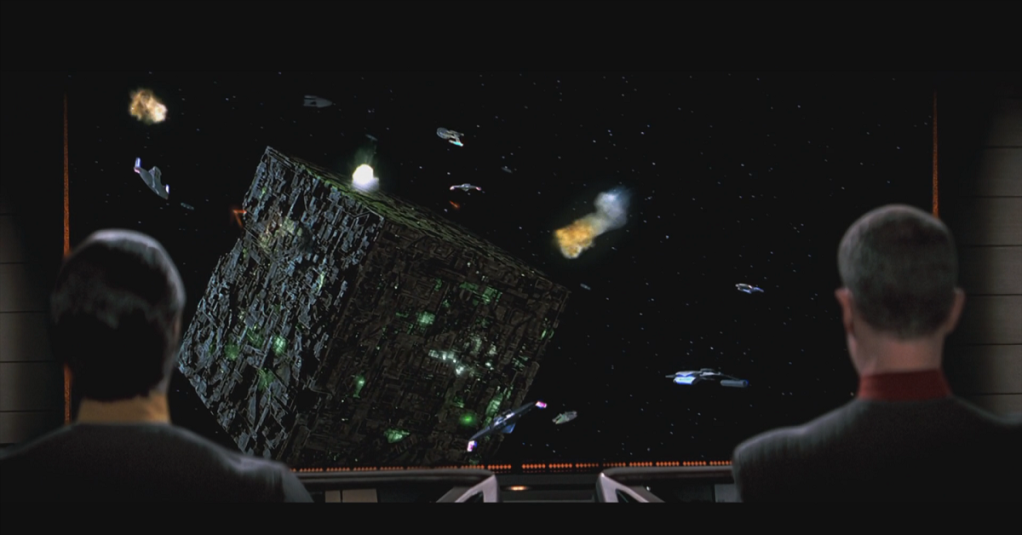

Screen capture from Star Trek: First Contact
Ever since President Trump first announced his intentions to establish a new branch of the American Armed Forces dedicated specifically to space and orbital defense, imaginations have run wild with what this new era of conflict miles above our heads might look like. Decades worth of movies and video games have shaped our idea of war among the stars, and it’s hard not to let our imaginations run a bit wild when the concept of zero-G warfighting is suddenly so real that our lawmakers are actually budgeting for it.
The thing is, our ideas of space warfare and the reality of conflict in space are pretty far off from one another… at least for now. America’s near-peer opponents in China and Russia have both already stood accused by the international community of launching weapons systems into orbit, but these aren’t Decepticons equipped with doomsday lasers and vessels full of jet-pack laden Space Marines. Warfare in space doesn’t take nearly that much effort or panache. In fact, in some cases, an act of war would require little more than a nudge. In practice, there’s very little difference between the sorts of tools being developed to capture and destroy space junk and weapons being designed to capture and destroy satellites.
Space harpoon skewers ‘orbital debris’
The truth is, America’s massive orbital infrastructure was largely deployed in an era with no serious competitors on the horizon. That means many of the satellites we rely on for communications, navigation, and defense lack any real means of defending themselves from attack or even moving out of the way of many kinds of danger. Departing Air Force Secretary Heather Wilson aptly described it by saying the United States had built “a glass house before the invention of stones.” Like a glass house, our satellite infrastructure is incredibly vulnerable, and now America’s opponents have already begun throwing stones.
The 1967 Outer Space Treaty outlines what its framers hoped would be the path to peaceful coexistence in orbit and beyond, but the language of the treaty allows for a great deal of latitude when it comes to orbital weapons. China, Russia, and the United States are all among the signatory members of the treaty, alongside a long list of others. Article IV of the treaty bans any signatory nation from deploying nuclear weapons (or other weapons of mass destruction) in orbit, and while other portions of the treaty also attempt to dissuade a real-life remake of Star Wars, the treaty itself bars little else when it comes to weapons.
Of course, that hasn’t stopped nations like Russia from referencing the 1967 Outer Space Treaty when accusing the United States of violating international norms during ongoing debates about the future of American space defense. This bit of tomfoolery notwithstanding, America, Russia, and China do want to appear as though they’re honoring the intent of this treaty, and as a result, orbital weapons often come in the guise of something else entirely. Russia’s Inspector satellites, for instance, are believed to have been designed specifically for use as a weaponized platform that can both eavesdrop on nearby satellite communications and directly interact with other orbital platforms.

Ground based lasers may soon be able to blind satellites temporarily, wreaking havoc with communications, navigation, and early warning systems.
(USAF Photo)
All an Inspector satellite would need to do in order to poke a hole in America’s defensive infrastructure is grab an American satellite with a retractable arm and pull it down into a degrading orbit. Eventually, the Russian satellite would just let go and watch its target burn up as it enters the atmosphere. The entire process would be fairly slow and even mundane to look at, but without any form of defense in orbit, there would be nothing U.S. Space Command could do but watch until the satellite went dark.
Similar methods to the same end would include deploying nets to capture enemy satellites or even simply giving them a push. Depending on the age and capability of the satellite, that could really be all it took to take it out of commission. In extreme cases, like the satellites the U.S. relies on to identify nuclear ballistic missile launches, simply incapacitating a satellite for a few minutes (by pushing it off its axis, for instance) could neuter the nation’s ability to spot or intercept inbound nukes. China has already demonstrated the theoretical ability to do exactly that using ground-based lasers that are invisible to the naked eye.
There are a number of strategies already being developed to counter this form of orbital warfare, like developing a fast-launch infrastructure to replace damaged satellites rapidly and deploying more maneuverable and capable platforms that aren’t as susceptible to these simplistic forms of attack… but for the next few decades, that’s the reality of our space wars: simple satellite drones nudging, poking, and maybe shooting at one another while we watch from below with bated breath.
